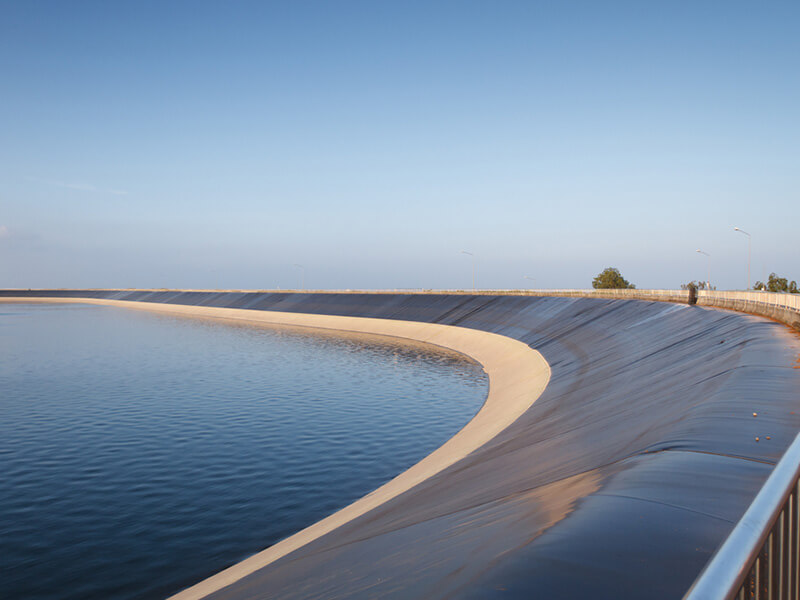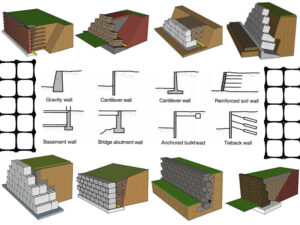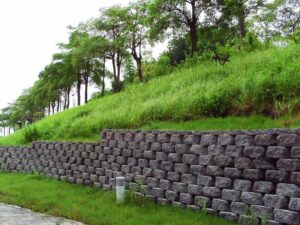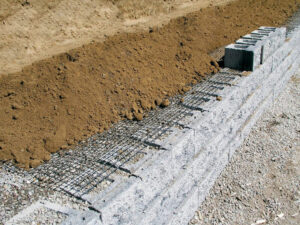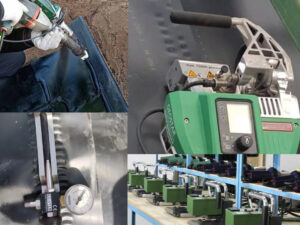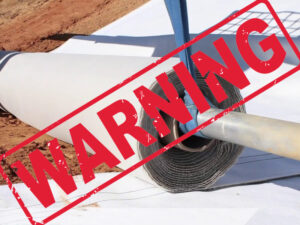Hello, I’m QIVOC. In this article, I’ll provide detailed information about geomembranes. If you want to learn more about geomembranes, this article will be perfect for you. Feel free to click the links below to navigate the sections you want to explore.
What is a Geomembrane?
Geomembrane, a synthetic membrane with extremely low permeability, commonly appears as a liner in geotechnical and civil engineering projects. Its primary function is to prevent the infiltration of fluids in various projects. These fluids may include water, chemical solutions, oil, and gases. There are various materials used in the manufacturing of geomembranes, such as polyethylene (PE), ethylene-vinyl acetate copolymer (EVA), polyvinyl chloride (PVC), ethylene copolymer bitumen (ECB), natural rubber, and others. The process involves melting these materials and adding suitable additives to form sheets, giving them the designation of geomembranes. Each material possesses distinct characteristics, allowing for the selection of the appropriate geomembrane based on the specific requirements of the engineering project.
When Was Geomembrane Invented?
The origin of geomembranes as a construction material dates back to the early 20th century. In its initial stages, geomembranes were produced by coating natural materials such as paper and textiles. With the emergence and development of polymer materials, researchers started developing more durable and high-performance geomembranes. In the 1930s, the United States began utilizing polyvinyl chloride (PVC) in the production of geomembranes, marking the birth of modern geomembranes.
During the 1930s, the U.S. applied geomembranes for bottom lining and seepage control in swimming pools. Following this, Europe also started using geomembranes for seepage control in fish farming and swimming pools. Later, geomembranes found applications in canal lining, where laying a 0.5mm geomembrane covered with 40cm of soil proved to protect against seepage, lasting for over 50 years. Geomembranes laid in the early 1940s have remained intact after more than 60 years.
In the 1960s, geomembranes were gradually applied in areas such as dam seepage prevention, playing a role in retrofitting early concrete dams for effective seepage control. These treated dams have maintained good operational conditions and effective seepage prevention.
In the 1990s, geomembranes were employed in earth-rock dams for functions like hydroelectric power generation, irrigation, and urban water supply. Over more than 20 years of operation, these dams have demonstrated high efficiency and maintained good water quality.
In the subsequent decades, geomembranes have found widespread applications in various fields, including water conservancy projects, highway construction, tunnel engineering, and more. Particularly in water conservancy projects, geomembranes have become a key material for seepage prevention. With the increasing awareness of environmental protection, geomembranes have also found extensive use in addressing environmental pollution, such as in water pollution control and soil remediation.
How Geomembranes Are Manufactured?
There are two manufacturing methods for geomembranes: blown film geomembranes are produced using the blown film process, while sprayed film geomembranes are manufactured using the spray film process.
Blown Film Geomembrane
The production process of blown film geomembranes mainly includes material preparation, extrusion molding, thickness stretching, cooling shaping, and cutting and rolling.
- Before the production process of blown film geomembranes, it is necessary to prepare the raw materials. The main components of geomembranes are high molecular materials such as polyethylene or polypropylene. These raw materials need to be mixed in a certain proportion and supplemented with the appropriate amount of additives and reinforcing fillers. The prepared materials undergo thorough mixing and maturation to enhance the performance of the geomembrane.
- The prepared materials are fed into an extruder for extrusion molding. The extruder, through heating and pressure, extrudes the high molecular materials into a thin film. The screw inside the extruder stirs and melts the materials, which are then extruded through a die head and cooled and shaped by a cooling roller.
- Stretch the cooled and shaped geomembrane for thickness. During the thickness stretching process, the cooled and shaped film passes through a pair of wheels, applying a certain stretching force between the wheels to ensure the film’s thickness is uniform and meets the required standards. Thickness stretching is a crucial step to ensure the consistency and stability of the geomembrane thickness.
- Cool and shape the stretched geomembrane. The cooling and shaping machine uses cooling rollers and an air cooling system to cool the stretched film, solidifying it. Temperature and cooling speed must be carefully controlled during the cooling and shaping process to ensure the performance and quality of the geomembrane.
- Cut and roll the cooled and shaped geomembrane. A cutting machine trims the cooled and shaped film according to different size requirements. Subsequently, a rolling machine rolls the cut film into cylindrical shapes for convenient storage and transportation.
Sprayed Film Geomembrane
Sprayed film geomembrane, also known as cast film, is a non-stretched, non-oriented flat extruded film produced by melt extrusion and rapid cooling.
- High-density polyethylene particles, moisture-proof agents, colorants, carbon black, and other raw materials are proportionally mixed in appropriate ratios and uniformly stirred before being fed into the material bin.
- The extruder heats and melts the raw materials such as polyethylene particles into a fluid state, and then, through an extrusion and appropriate slit width, extrudes the geomembrane. The extruded geomembrane is cooled and shaped by cooling rollers with a cooling agent.
- After cutting to the desired width and length, the geomembrane is packaged into rolls according to customer requirements.
A Comparison of Two Manufacturing Processes
The blown film geomembrane and sprayed film geomembrane also exhibit differences in performance. Blown film geomembranes generally have thinner thicknesses, typically ranging between 0.5-2.0mm. They possess higher strength and puncture resistance, making them suitable for applications such as seepage control and waterproofing in civil engineering projects.
In contrast, sprayed film geomembranes have a greater thickness, typically ranging between 2-8mm. They demonstrate higher durability and resistance to aging, making them suitable for applications like soil and water conservation, and pollution prevention, particularly in river and reservoir management projects.
Additionally, the production costs of blown film geomembranes and sprayed film geomembranes differ. The manufacturing process of blown film geomembranes is relatively simple, resulting in lower costs, and consequently, widespread application in civil engineering projects. On the other hand, the production process of sprayed film geomembranes is relatively complex, leading to higher costs. However, they offer superior durability and aging resistance, making them suitable for long-term engineering applications.
What Are the Types of Geomembrane?
Geomembranes can be classified based on their manufacturing materials, surface shapes, and applications.
Classification by Manufacturing Materials
Geomembranes can be categorized into various types based on the material used in their manufacturing, including HDPE (High-Density Polyethylene), LDPE (Low-Density Polyethylene), LLDPE (Linear Low-Density Polyethylene), PVC (Polyvinyl Chloride), EPDM (Ethylene Propylene Diene Monomer), RPP (Reinforced Polypropylene), TRP (Thermoplastic Rubber), composite materials, and more.
HDPE Geomembrane:
HDPE geomembrane, made from high-density polyethylene, is the most widely used type. Its preference in lining projects is attributed to its durability, strong UV resistance, and relatively low material cost.
HDPE geomembranes are commonly chosen for exposed applications such as landfill sites, reservoir covers, ponds, and canal liners. With greater thickness, lighter weight, enhanced chemical resistance, and resistance to higher temperatures, HDPE geomembranes excel in large-scale applications that require high-quality installations. Additionally, HDPE is food-safe, making it suitable for storing drinking water.
LDPE Geomembrane:
LDPE geomembranes, manufactured from low-density polyethylene, exhibit good flexibility and elongation. They are suitable for applications where a certain level of bending performance is required, such as in riverbed seepage and foundation waterproofing.
LLDPE Geomembrane:
LLDPE geomembranes, made from linear low-density polyethylene, combine the characteristics of HDPE and LDPE. They offer excellent mechanical performance, resistance to chemical corrosion, tolerance to low temperatures, and UV resistance. LLDPE geomembranes are suitable for long-term use and can maintain strength and durability for many years. They find applications in industrial settings, including liquid storage tanks, and environmental and animal waste containers.
PVC Geomembrane:
PVC geomembranes are thermoplastic waterproof materials made from ethylene, plasticizers, and stabilizers. They possess good flexibility, chemical resistance, tear resistance, puncture resistance, and abrasion resistance. PVC geomembranes are ideal for preventing pollutants from entering water sources and maintaining potable water. They are suitable for applications such as industrial wastewater treatment ponds, chemical pools, and areas requiring resistance to chemical corrosion.
EPDM Geomembrane:
EPDM geomembranes, made from ethylene propylene diene monomer rubber, resist punctures and extreme weather conditions. With a rubber-like texture, good strength, and UV stability, they are commonly used as surface barriers in dams and other irrigation facilities, such as irrigation ponds.
RPP Geomembrane:
RPP geomembranes, made from UV-stabilized polypropylene copolymers, are suitable for applications where wrinkles may occur due to uneven and inconsistent weather conditions. Supported by a nylon scrim, RPP geomembranes ensure durability. This type is typically used in municipal applications, aquaculture and horticulture, evaporative pond liners, and tailings.
TRP Geomembrane:
TRP geomembranes are made using polyethylene fabric and are an ideal choice for lining temporary water storage tanks. They are effective in providing a long-term solution for soil remediation issues. Physical characteristics include chemical resistance, a low-temperature range, and UV stability. This type of geomembrane is used in canals, industrial waterproof fabrics, landfill sites, and agricultural and municipal applications.
Composite Geomembrane:
Composite geomembranes are made through a composite process using different types of materials. They integrate the advantages of various materials, offering comprehensive performance. Widely used in channel seepage control projects, composite geomembranes exhibit high tensile strength, tear resistance, puncture resistance, and other physical and mechanical properties. They meet the needs of civil engineering projects in water resources, municipal engineering, construction, transportation, subway, tunnel, and more. Due to the use of polymer materials and the addition of anti-aging agents in the production process, they can be used in unconventional-temperature environments.
Classification by Surface Shape
Geomembranes can be primarily categorized into three types based on their surface shapes: double smooth surface, single rough surface, and double rough surface.
Double Smooth Surface Geomembrane:
A double smooth surface geomembrane has smooth surfaces on both the top and bottom. The design of smooth surfaces results in a low friction coefficient between membranes, making it easy to install. This type is suitable for projects with low friction force requirements.
Single Rough Surface Geomembrane:
A single rough surface geomembrane has one side with a rough surface and the other with a smooth surface. The rough surface increases the friction coefficient, providing anti-slip functionality. It is more suitable for steep slopes and vertical anti-seepage applications, enhancing project stability. In the construction of slope anti-seepage projects, the rough surface of the geomembrane often comes into contact with geotextiles, achieving an anti-slip effect.
Double Rough Surface Geomembrane:
A double rough surface geomembrane has rough surfaces on both sides. It exhibits excellent anti-slip performance with a high friction coefficient. This type of geomembrane has versatile applications and can be in contact with geotextiles on both sides during slope engineering construction, achieving effective anti-slip results.
Classification by Application
Geomembranes can be categorized based on their applications into aquaculture geomembranes (pond geomembranes for fish and shrimp), engineering geomembranes (landfills, biogas tanks, water treatment), and other uses.
Aquaculture Geomembranes:
Aquaculture geomembranes include those specifically designed for fish ponds and shrimp tanks. These geomembranes serve the purpose of providing a lining solution to contain water in aquaculture facilities, ensuring a controlled and secure environment for fish and shrimp farming.
Engineering Geomembranes:
Engineering geomembranes find application in various construction projects. This category encompasses geomembranes used in landfills for waste disposal, biogas tanks for the collection of methane from organic waste, and water treatment facilities where geomembranes play a role in containing and managing liquids.
Other Uses:
This category encompasses geomembranes utilized for purposes other than aquaculture and engineering applications. The specific applications may vary widely based on the unique requirements of different projects and industries.
What is the Use of Geomembrane?
Geomembranes are a highly versatile product with wide-ranging applications in environmental engineering, water conservancy projects, municipal engineering, landscaping, petrochemicals, mining, transportation, agriculture, and more.
Environmental Protection and Sanitation:
Landfills, sewage treatment plants, power plant regulating ponds, solid waste disposal in industrial and hospital settings, etc.
Water Conservancy Projects:
Seepage prevention, leak plugging, reinforcement, and canal lining for rivers, lakes, reservoirs, and dams; seepage prevention, vertical cutoff walls, slope protection, etc.
Municipal Engineering:
Subways, underground construction, green roofs, rooftop gardens, sewage pipe seepage prevention, etc.
Landscaping:
Artificial lakes, rivers, reservoirs, pond bottoms for golf courses, slope protection, waterproofing for green lawns, etc.
Petrochemicals:
Seepage prevention for chemical plants, oil refineries, lining for oil storage tanks, chemical reaction tanks, lining for settling ponds, secondary lining, etc.
Mining:
Linings for washing ponds, leaching ponds, ash yards, dissolution ponds, settling ponds, yards, and seepage prevention for tailings.
Transportation Facilities:
Reinforcement of highway foundations, seepage prevention for culverts, etc.
Agriculture:
Seepage prevention for reservoirs, drinking water ponds, water storage ponds, irrigation systems, etc.
Aquaculture Industry:
Lining for intensive and industrialized cultivation ponds, fish ponds, shrimp ponds, slope protection for sea cucumber enclosures, etc.
Salt Industry:
Linings for salt field crystallization ponds, tarpaulin coverings for brine pools, salt films, plastic tarpaulins for salt ponds, etc.
Specific purposes are as follows:
As liners for potable water
As liners for reserve water (e.g., safe shutdown of nuclear facilities)
As liners for waste liquids (e.g., sewage sludge)
Liners for radioactive or hazardous waste liquid
As liners for secondary containment of underground storage tanks
As liners for solar ponds
As liners for brine solutions
As liners for the agriculture industry
As liners for the aquaculture industry, such as fish/shrimp pond
As liners for golf course water holes and sand bunkers
As liners for all types of decorative and architectural ponds
As liners for water conveyance canals
As liners for various waste conveyance canals
As liners for primary, secondary, and/or tertiary solid-waste landfills and waste piles
As liners for heap leach pads
As covers (caps) for solid-waste landfills
As covers for aerobic and anaerobic manure digesters in the agriculture industry
As covers for power plant coal ash
As liners for vertical walls: single or double with leak detection
As cutoffs within zoned earth dams for seepage control
As linings for emergency spillways
As waterproofing liners within tunnels and pipelines
As waterproof facing of earth and rockfill dams
As waterproof facing for roller compacted concrete dams
As waterproof facing for masonry and concrete dams
Within cofferdams for seepage control
As floating reservoirs for seepage control
As floating reservoir covers for preventing pollution
To contain and transport liquids in trucks
To contain and transport potable water and other liquids in the ocean
As a barrier to odors from landfills
As a barrier to vapors (radon, hydrocarbons, etc.) beneath buildings
To control expansive soils
To control frost-susceptible soils
To shield sinkhole-susceptible areas from flowing water
To prevent infiltration of water in sensitive areas
To form barrier tubes as dams
To face structural supports as temporary cofferdams
To conduct water flow into preferred paths
Beneath highways to prevent pollution from deicing salts
Beneath and adjacent to highways to capture hazardous liquid spills
As containment structures for temporary surcharges
To aid in establishing uniformity of subsurface compressibility and subsidence
Beneath asphalt overlays as a waterproofing layer
To contain seepage losses in existing above-ground tanks
As flexible forms where loss of material cannot be allowed.
How Does a Geomembrane Work?
A geomembrane is a type of thin film with impermeable functionality, primarily designed to prevent the infiltration of liquids or gases through its unique material structure. It is crafted from polymer materials, possessing extremely tiny and sealed pore structures. This is achieved through material preparation and processing, aimed at minimizing or preventing the permeation of moisture, gases, or other substances.
For instance, HDPE materials typically exhibit a dense structure, with micro-pores so small that it becomes challenging for cracks or permeating substances to penetrate. Other materials are also engineered during the preparation process to feature pore structures as airtight as possible.
Furthermore, geomembranes can prevent the passage of gases, thanks to their anti-gelation properties resulting from the sealed structure and selected polymeric materials. This tight structure reduces gas permeation, thwarting the penetration of gases. This characteristic makes geomembranes particularly effective in engineering projects where preventing gas infiltration is crucial, such as defense against methane and hydrogen.
In construction projects, geomembranes are laid on the base soil, forming a waterproof barrier that effectively prevents moisture from infiltrating the underlying soil. Simultaneously, by creating an isolation layer, geomembranes can prevent the movement and mixing of soil particles, improving the foundation structure and enhancing its stability. Additionally, geomembranes can be utilized to reinforce the bearing capacity of foundations and can be employed in the compaction process of the foundation.
How to Install or Use Geomembrane Liner?
Using and installing a geomembrane is straightforward and convenient. Below is a standard construction process.
- Before commencing installation, thoroughly clean the construction area, removing any sharp objects and debris to ensure a smooth foundation.
- Measure the length and width of the geomembrane accurately for precise cutting by project requirements. Ensure complete coverage of the targeted project area.
- Lay the cut geomembrane in the designated area, taking care to avoid wrinkles.
- In cases where the construction area exceeds the width of the geomembrane, seam welding is necessary. Utilizing a dedicated welding machine for seam processing ensures superior impermeability.
- Secure the edges and joints of the geomembrane using fixed strips, nails, etc. Ensure the geomembrane remains stationary during use.
How to Weld Geomembrane?
Geomembranes can be welded using various methods, and here we will primarily discuss three welding techniques: hot air welding, dual-track hot melt welding, and extrusion welding. Let’s delve into each method separately.
Hot Air Welding:
- Preparation: Cut the edges of the two geomembranes to be welded in a straight line using a blade or cutting machine, and clean any impurities from the edges.
- Fixation: Secure the hot air welding machine at the edges of the geomembrane.
- Alignment: Align the edges of the two geomembranes and place them under the hot air welding machine.
- Activation: Start the machine, allowing hot air to be emitted. This heats and melts the edges of the geomembranes.
- Welding: Quickly press the melted edges of the two geomembranes together and use a pressure roller to compact them, ensuring a strong adhesive bond.
Dual-Track Hot Melt Welding:
Pre-construction Preparation:
- Overlap Width Inspection: Verify the overlap width after laying the film; the welding seam overlap length should be 80-100mm.
- Surface Cleaning: Before welding, clean the membrane surface within approximately 200mm of the overlap area. Use a damp cloth to remove dust and dirt, ensuring the area remains clean and dry.
- Condition Checks: Ensure that the welding area is free from scratches, stains, moisture, dust, or any other impurities that may hinder welding and affect construction quality.
- Parameter Setting: Before the actual welding operation, set equipment parameters based on experience and conduct a trial weld on a 300×600mm membrane segment.
- Temperature Consideration: Welding of geomembranes should not be conducted when the ambient temperature is above 40°C or below 5°C.
Operational Guidelines:
- Preheating: After turning on the machine, carefully observe the temperature rise indicated on the instrument panel to ensure the equipment is adequately preheated.
- Insertion: When inserting the membrane into the welding machine, ensure accurate overlap dimensions and execute the motion swiftly.
- Monitoring and Adjustment: During welding, closely monitor the condition of the weld seam and adjust the welding speed promptly to ensure welding quality.
- Maintaining Seam Straightness: Keep the weld seam straight and neat throughout the welding process. Address any unevenness beneath the membrane promptly to avoid hindering the machine’s smooth operation. In the event of specific malfunctions, stop the machine promptly to prevent damaging the membrane.
Extrusion Welding:
Pre-construction Preparation:
- Surface Inspection: Check if the base layer at the seam is smooth and solid. If there are foreign objects, address them appropriately beforehand.
- Overlap Width Check: Ensure the overlap width at the welding seam is appropriate (≥60mm), and the membrane at the seam is smooth with moderate tension.
- Positioning Adhesion: Use a hot air gun to bond the overlap area of the two membranes. The spacing between bonding points should not exceed 60-80mm. Control the temperature of the hot air to avoid scorching the geomembrane while ensuring it is not easily torn.
- Feathering: Use a feathering machine to feather the membrane surface within a 30-40mm width around the welding seam, achieving thorough cleaning and creating a rough surface. This increases the contact area without exceeding 10% of the membrane thickness. For membranes with a thickness equal to or greater than 2mm, create a 45° bevel during feathering.
- Trial Welding: Before formal welding, take a sample of no less than 300×600mm and conduct a trial weld with preliminary equipment parameters based on experience. The success or failure criterion for the trial weld is that the membrane can be torn but without damage to the weld seam during shear and peel tests.
Operational Procedure:
- Alignment: Align the welding head with the seam during welding, avoiding misalignment, sliding, or skipping.
- Weld Seam Thickness: The thickness at the center of the weld seam should generally be 2.5 times the thickness of the impermeable membrane and not less than 3mm.
- Interrupted Welding: When a seam cannot be continuously welded, feather at least 50mm of the already welded part before proceeding with the overlap welding.
- Cooling: Promptly cool the weld seam according to the temperature conditions.
How to Test Geomembrane?
After the completion of geomembrane construction, the integrity of the geomembrane is crucial for ensuring the high-quality completion of the project. Here, three methods for testing geomembrane integrity will be introduced.
Visual Inspection Method:
The visual inspection method is a simple approach that involves observing the surface condition of the geomembrane to check for defects such as damage, cracks, or holes. This method is suitable for small areas of geomembrane testing but may be limited in detecting minute defects.
Air Pressure Testing Method:
The air pressure testing method is a more accurate approach. It involves introducing a certain pressure of air into the interior of the geomembrane and observing whether there are bubbles or bulges on the surface, allowing for an assessment of geomembrane integrity. This method is suitable for testing large areas of geomembrane.
Air Pressure Testing Method with Air Pressure Tester:
Experimental Equipment:
Experimental Procedure:
- Seal both ends of the unsealed gas channel in the middle of the dual-track welding.
- Insert the needle of the pressure gauge into one sealed end or choose a point in the middle.
- Introduce high-pressure air into the channel until the pressure reaches 170200 kPa (25 – 30 psi). After pressurization, remove the compressed air and maintain this pressure for a 5-minute test.
- If the pressure drops by more than 0.25 kPa (4 psi) or if the pressure exhibits instability, mark the tested area for retesting or repair.
- If the pressure remains stable throughout the test period, open the seal at the other end. At this point, the gas channel, which has expanded due to the pressure, should immediately contract and dissipate, indicating that the entire length of the welding has been successfully tested.
Ultrasonic Testing Method:
The ultrasonic testing method is a non-destructive testing approach that involves emitting ultrasonic waves into the interior of the geomembrane. The reflected ultrasonic wave signals are then received, analyzed, and compared to identify any anomalies. This method is particularly suitable for detecting thicker geomembranes.
When to Use Geomembrane?
Geomembranes serve various crucial functions, including preventing seepage, reinforcing and isolating soil, and preventing settlement. Therefore, geomembranes find applications in a wide range of projects, from small-scale projects like household swimming pools and fish ponds to large-scale coastal, water management, and construction projects. If you encounter situations in daily life where seepage prevention, soil reinforcement, isolation, or settlement prevention are needed, geomembranes can be a valuable solution.
Geomembranes play a significant role in the following areas:
Water Management Projects:
Geomembranes are widely used in water management projects for seepage prevention, such as in reservoirs, dams, and river channel management. Installing geomembranes effectively prevents water leakage, enhances the stability of dams, and extends their lifespan.
Environmental Protection:
In the field of environmental protection, geomembranes find extensive applications in soil remediation and solid waste management. By laying geomembranes, harmful substances can be effectively prevented from permeating, safeguarding the safety of soil and groundwater resources.
Construction Projects:
Geomembranes are widely employed in construction projects, including waterproofing basements and roofs. Installing geomembranes effectively enhances the waterproofing performance and stability of buildings, protecting them from water damage.
Other Areas:
Beyond the mentioned sectors, geomembranes are also widely used in road construction, agriculture, mining, and other fields. They serve as a protective layer, shielding various infrastructure and resources from water damage.
For more information, you can explore the topic “What is the use of geomembrane?” to gain further insights.
Why Geomembranes are Used?
Geotextile membrane has significant advantages over other methods in terms of leak prevention, soil reinforcement, and settlement prevention. These advantages make geotextile membranes a crucial product in various engineering projects.
The key advantages of geotextile membrane include:
Excellent Leak Prevention Performance
Geotextile membrane exhibits outstanding leak prevention performance, effectively preventing the infiltration of liquids and gases. This leak prevention capability finds applications in various engineering projects such as hydraulic engineering and environmental protection projects.
Strong Aging Resistance
Geotextile membrane demonstrates excellent resistance to aging, enabling long-term use in natural environments. Even after prolonged exposure to weathering and corrosion, it does not show significant performance degradation.
Simple Construction
The construction of a geomembrane is relatively straightforward, utilizing methods like burial and laying. Due to its lightweight nature, ease of transport, and installation, the construction period can be significantly shortened, enhancing overall project efficiency.
Cost-Effective
Compared to other materials, geotextile membranes are economically viable, effectively reducing project costs. Additionally, its excellent performance and extended lifespan contribute to substantial savings in maintenance and replacement expenses.
Where to Buy Geomembrane?
Purchasing a geomembrane is incredibly simple and convenient, depending on your buyer profile.
For individual buyers looking to create a home swimming pool, fish pond, or enhance a home garden, the process is straightforward. You can easily buy small quantities of geomembrane on platforms like Amazon (because many manufacturers have a minimum order requirement of at least 5000 square meters). Keep in mind that the geomembrane available on Amazon might be slightly more expensive compared to purchasing directly from manufacturers.
If you represent various corporate engineering projects, it’s advisable to procure geomembrane from reputable suppliers and manufacturers.
Of course, you can choose to purchase a geomembrane from us at QIVOC. We offer high-quality and cost-effective geomembrane, providing complimentary engineering solutions and post-purchase guidance. With no minimum order requirements, you can benefit from our meticulous service and support regardless of the quantity you need.
What is the Difference Between Geotextile Fabric and Geomembrane?
Geotextile fabric and geomembrane are two distinct geotechnical products with differences in usage, functions, raw materials, and more.
Key differences:
Geotextile fabric is permeable.
Geomembrane is impermeable.
Manufacturing materials:
Geotextile fabric is processed from non-woven fabrics made of polyester, polypropylene, acrylic, nylon, and others.
Geomembrane is typically made from high and low-density polyethylene, EVA, and other materials, forming an impermeable membrane.
Functions:
Geotextile fabric is primarily used for soil reinforcement.
Geotextile fabric functions include filtration, drainage, separation, reinforcement, protection, sealing, and various other purposes.
Geomembrane is primarily used for leak prevention.
Geomembrane functions include leak prevention, isolation, reinforcement, crack prevention, strengthening, and horizontal drainage for leak prevention.
Applications:
Geotextile fabric is mainly applied in road construction, railways, airports, river channels, slope protection, maintenance, landscaping, and other projects.
Geomembrane is primarily used in aquaculture, wastewater treatment facilities, landfill sites, tailings storage facilities, channel leak prevention, dam leak prevention, and subway engineering.
Advantages:
Geotextile fabric, whether woven or non-woven, exhibits excellent filtering, drainage, isolation, reinforcement, leak prevention, and protection properties. It is lightweight and has high tensile strength, good permeability, resistance to high temperatures, anti-freezing capability, aging resistance, and corrosion resistance.
Geomembrane, utilizing plastic film as the base material, is a polymer chemical flexible material with low density, high elongation, high adaptability to deformation, corrosion resistance, low-temperature resistance, and good anti-freezing performance.
Finally
Based on the specific requirements of different projects, geomembrane, and geotextile fabric are often used in combination. Geotextile fabric serves as a protective layer, cushioning layer, drainage and ventilation layer, and reinforcement layer for geotextile membrane, with the geomembrane acting as the primary barrier for leak prevention.
What is the Difference Between Geomembrane and HDPE?
HDPE is one type of geomembrane, belonging to the category of geomembranes. They differ in several aspects.
Material:
High-Density Polyethylene (HDPE) impermeable membranes are made from high-density polyethylene resin.
Geomembranes, on the other hand, can be manufactured from various materials such as polyethylene, polyvinyl chloride, polypropylene, and more.
Characteristics:
Due to the differences in materials, HDPE impermeable membranes exhibit superior performance in tensile strength, puncture resistance, and chemical stability compared to geomembranes, which vary in performance based on the materials used.
Applications:
HDPE impermeable membranes are typically used to prevent leakage of water and waste, commonly employed in construction projects like landfill sites, reservoirs, sewage treatment plants, and similar engineering projects.
Geomembranes, on the other hand, find applications in soil stabilization, corrosion resistance, waterproofing, and various other fields.
Price:
Due to disparities in materials and characteristics, HDPE impermeable membranes are generally priced higher than geomembranes.
In the End
Geomembranes are a key material extensively used in various engineering applications, playing a vital role in impermeability and environmental protection. In this article, we’ve delved into multiple aspects related to geomembranes and provided detailed answers accordingly. Feel free to bookmark it for future reference. And, if you’re considering the purchase of geomembranes, do not hesitate to get in touch with us. For any additional inquiries, please leave a comment in the section below.
Lastly, keep our brand in mind: QIVOC. We are a brand committed to delivering high-quality products with utmost dedication to customer satisfaction.
References
www.earthshields.com/what-are-the-types-of-geomembrane/
industrialplastics.com.au/geomembrane-explained/
baike.baidu.com/item/%E5%9C%9F%E5%B7%A5%E8%86%9C?fromModule=lemma_search-box
en.wikipedia.org/wiki/Geomembrane
www.xianjichina.com/news/details_299383.html

